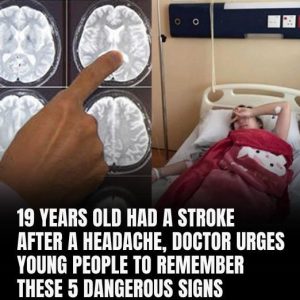The story of a 19-year-old who had a stroke following a headache serves as a reminder that cerebrovascular accidents can occur in young people as well.
To guarantee prompt medical intervention, it is crucial to identify the early indicators.
- An abrupt, intense headache What Takes Place: a sudden headache that is not like other headaches or feels especially strong. Meaning of It: can be a sign of clogged blood arteries or brain hemorrhage.
- Feeling weak or numb What Takes Place: weakness, numbness, or tingling, especially on one side of the body (face, arm, or leg). Meaning of It: a reduction in blood flow to specific brain regions.
- Having trouble understanding or speaking What Takes Place: trouble comprehending people, slurred speech, or trouble formulating words. What It Means: There may be an impact on the language center of the brain.
- Issues with Vision What Takes Place: One or both eyes may suddenly lose their vision, become blurry, or experience double vision. What It Means: The parts of the brain involved in vision can be harmed by a stroke.
- A loss of coordination or balance What Takes Place: dizziness, difficulty walking, or an abrupt lack of coordination. What It Means: Movement and balance are controlled by the cerebellum, which may be impacted.
At the end of the day, milia are harmless. Apart from its unpleasant appearance, it won’t hurt us and will go away in its own time. If you are concerned about your milia and wish to treat it, then speak with your doctor about an appropriate way to do that. Otherwise, just let these little bumps do their thing, and they’ll soon be on their way.





Giveaway Free E-BOOK


How To Watch Any Movies / TV Shows Online For Free
Say no to monthly subscription, download and stream movies free

Giveaway Free E-BOOK


How To Watch Any Movies / TV Shows Online For Free
Say no to monthly subscription, download and stream movies free











